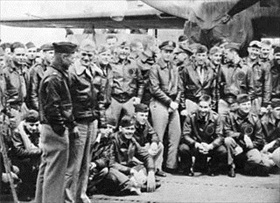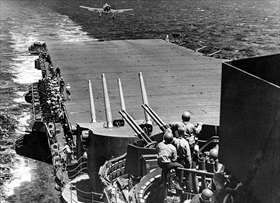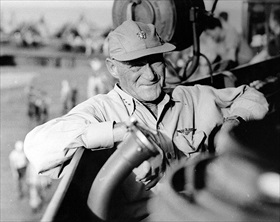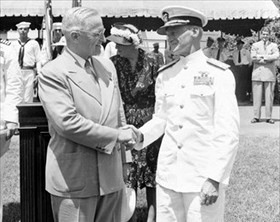CARRIER FORCE TO CLAIM SKIES FOR U.S.
Ulithi Atoll, Western Pacific · February 10, 1945
On this date in 1945 Task Force 58 under Vice Adm. Marc “Pete” Mitscher, assigned to U.S. Adm. Raymond Spruance’s Fifth Fleet, steamed out of its anchorage at Ulithi Atoll in the Caroline Islands, 1,700 miles/2,736 kilometers south of the main Japanese island of Honshū. Except for the Coral Sea standoff (May 4–8, 1942), Mitscher had been engaged in every major naval battle in the Pacific. As the U.S. Pacific Fleet’s senior carrier admiral, Mitscher now commanded the greatest assemblage of naval power on earth—16 fast carriers with close to 1,200 aircraft, 8 battleships, 15 cruisers, and 77 destroyers.
OnFebruary 16, Task Force 58 parked 60 miles/97 kilometers off Japan’s Honshū Island and began 9 hours of almost uninterrupted combat—the biggest day of air combat since the Great Marianas Turkey Shoot (the Battle of the Philippine Sea) the previous June. A pilot himself and a brilliant tactician, it was as if the 58‑year-old admiral had spent his lifetime preparing to fight this air battle. When the dogfights ended the next day, Task Force 58 and America controlled Japanese airspace. Mitscher’s aviators claimed 341 Japanese kills in the air and 190 on the ground. On the water, shipping around Tokyo suffered heavily, with 1 escort carrier, 3 destroyers, and 9 coastal vessels sunk. More than 20 other ships were damaged. Task Force 58 lost more than 80 planes to all causes, but the U.S. Navy could absorb losses such as these and continue operating. That month, American factories produced nearly 900 replacement aircraft. Japanese aircraft and engine complexes, the targets of much of the Navy’s anger, simply could not compete.
Mitscher’s carriers spearheaded the thrusts against Iwo Jima (February 19 to March 26, 1945) and Okinawa (April 1 to June 22, 1945). In July the Navy Department announced that Task Force 58 had destroyed or damaged 3,259 Japanese aircraft in the Okinawa campaign alone. (Okinawa was the high watermark for Japanese kamikaze pilots, who managed to sink 26 Allied ships and damage 160, including Mitscher’s carrier flagship USS Bunker Hill and the battleship USS Missouri, which survived its deadly encounter to host Japan’s surrender ceremonies in Tokyo Bay on September 2, 1945.) Mitscher received high praise for his Pacific record from Fleet Admiral Chester W. Nimitz: “It is doubtful if any officer has made more important contributions than he toward extinction of the enemy fleet.”
Adm. Marc A. “Pete” Mitscher, 1887–1947
 |  |
Left: Facing the camera Capt. Marc A. Mitscher, commander of the USS Hornet, chats with Lt. Col. James “Jimmy” Doolittle, the leader of the Army Air Forces attack group that carried the war to the Japanese capital, Tokyo, on April 18, 1942, nearly 5 months after Pearl Harbor. Behind the 2 men are the crews of the 16 B‑25B Mitchell medium bombers that the Hornet deposited within takeoff distance of the Japanese homeland. Without the loss of a single bomber over Japan, the Doolittle Raid demonstrated that the island nation itself was vulnerable to American air attacks, though it wasn’t until late 1944 that another air attack, this by B‑29 Superfortress heavy bombers flying from China, inflicted any damage on the Japanese Home Islands.
![]()
Right: During the Battle of the Philippine Sea (June 19–20, 1944), a Grumman F6F‑3 Hellcat is seen landing aboard the USS Lexington, the flagship of Vice Adm. Mitscher’s Task Force 58. The decisive naval battle, which took place during the U.S. amphibious invasion of the Mariana Islands, eliminated the Japanese Navy’s capability to conduct large-scale carrier actions. It proved to be the last of 5 major “carrier-versus-carrier” engagements between the 2 nations’ naval forces.
 |  |
Left: Mitscher aboard the USS Lexington during the Battle of the Philippine Sea. Mitscher’s fast carriers continued their assault on the Japanese Empire, taking part in the liberation of the Philippines (1944–1945) and the conquest of Iwo Jima (February to March 1945) and Okinawa (April to June 1945). Upon Mitscher’s return from the Okinawa campaign, Adm. Chester W. Nimitz, Commander in Chief of the U.S. Pacific Fleet, called Mitscher “the most experienced and most able officer in the handling of fast carrier task forces who has yet been developed.”
![]()
Right: President Harry S. Truman congratulates Adm. Mitscher, now Commander in Chief, U.S. Atlantic Fleet, during a White House ceremony in which 8 U.S. carriers were awarded Presidential Unit Citations, July 16, 1946. Besides being honored by the commands he held, Mitscher was the recipient of 2 Gold Stars in lieu of a second and third Navy Cross, the Distinguished Service Medal with 2 Gold Stars, and the Legion of Merit.
Short Biographical Tribute to Admiral Marc A. “Pete” Mitscher
![]()

 History buffs, there is good news! The Daily Chronicles of World War II is now available as an ebook for $4.99 on Amazon.com. Containing a year’s worth of dated entries from this website, the ebook brings the story of this tumultuous era to life in a compelling, authoritative, and succinct manner. Featuring inventive navigation aids, the ebook enables readers to instantly move forward or backward by month and date to different dated entries. Simple and elegant! Click
History buffs, there is good news! The Daily Chronicles of World War II is now available as an ebook for $4.99 on Amazon.com. Containing a year’s worth of dated entries from this website, the ebook brings the story of this tumultuous era to life in a compelling, authoritative, and succinct manner. Featuring inventive navigation aids, the ebook enables readers to instantly move forward or backward by month and date to different dated entries. Simple and elegant! Click 











